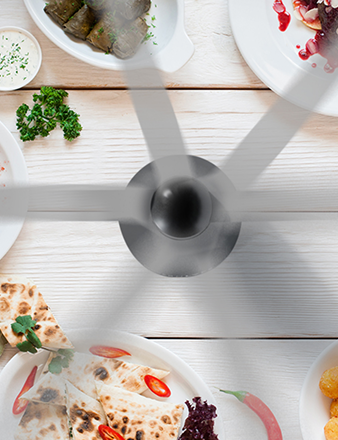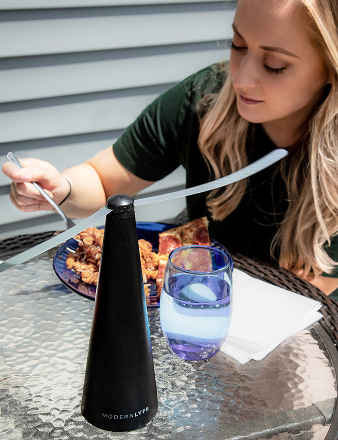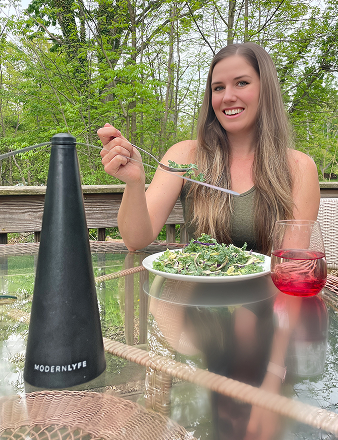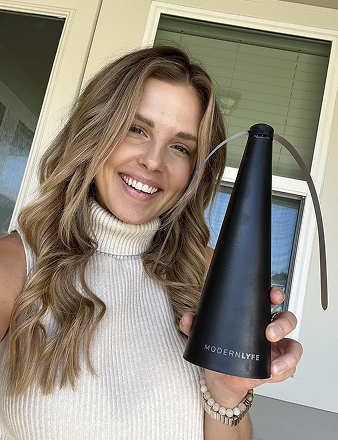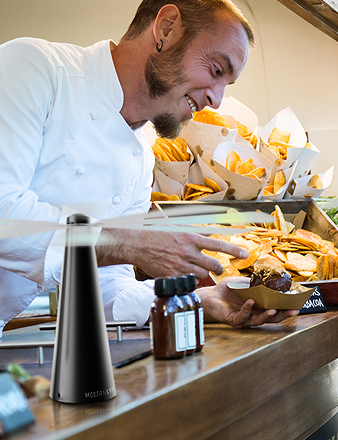A solid catering equipment checklist is the secret weapon behind any successful event. It ensures nothing gets left behind, from the first prep cut to the final cleanup. Think of it as your operational playbook—it saves you from last-minute scrambles and eliminates the stress of a chaotic setup.
Your Blueprint for Flawless Events
Planning a large event or launching a catering business can feel like juggling flaming torches. Without a solid plan, it's dangerously easy for something essential to slip through the cracks. Forgetting serving tongs or running out of chafer fuel can throw a wrench in your entire operation.
This is where a systematic checklist becomes your best asset. It's more than a list; it's your insurance policy against the chaos that derails an event. With an organized checklist, every tool and piece of equipment is accounted for. This frees up your team to do what they do best: create amazing food and deliver impeccable service. It's the foundation of a professional, smooth-running operation.
Why a Checklist Is Non-Negotiable
A detailed checklist does more than help you remember the spoons. It injects confidence and consistency directly into your workflow. The benefits are tangible and immediate.
- Eliminate Guesswork: Know exactly what you need for any event, whether it's an intimate corporate lunch or a 200-person wedding.
- Prevent Costly Mistakes: Stop making frantic, expensive runs to a rental shop for forgotten gear. A good checklist protects your bottom line.
- Look More Professional: Arriving fully prepared sends a powerful message. It tells clients and guests you're reliable, competent, and in control—which is huge for your reputation.
- Increase Team Speed: When your crew has a clear guide, they can pack, set up, and break down with incredible efficiency.
A catering equipment checklist is the silent partner in every successful event. It doesn't just list your tools; it structures your entire service, ensuring every detail is executed perfectly from start to finish.
This methodical approach is more critical than ever. The global commercial catering equipment market was valued at around USD 12.03 billion in 2024 and is projected to grow, showing just how much the industry is expanding. To thrive in this competitive space, you have to be organized.
As you build your equipment blueprint, include smart space-saving kitchen accessories to keep your operation mobile and efficient. This guide gives you that essential blueprint.
Essential Food Preparation and Prep Tools
A flawless event doesn’t just happen—it's built on hours of meticulous work behind the scenes. Your prep tools are the true workhorses of your operation, ensuring consistency and efficiency long before the first plate is served. Without the right equipment, even basic tasks can create a bottleneck, slowing your team and putting the entire timeline at risk.
Think of your toolkit like a master mechanic’s chest; the right wrench for every bolt makes the job run smoothly. It's about investing in reliable, commercial-grade tools that can withstand the fast pace of professional catering.
The Core of Your Prep Station
Every great dish starts with the basics. These are the non-negotiables your team will reach for again and again. Cutting corners here leads to slow prep times and inconsistent results that you can taste in the final product.
When choosing your gear, your mantra should be durability and function. For example, knives made from high-carbon stainless steel offer a great balance of a razor-sharp edge and the toughness to keep it. Likewise, NSF-certified cutting boards aren't just a good idea—they're essential for a safe and hygienic kitchen.
Here are the absolute must-haves:
- Chef’s Knives: A set of high-quality, sharp knives is the single most important investment for your prep station.
- Color-Coded Cutting Boards: These are your first line of defense against cross-contamination, keeping raw meats, fish, and produce safely separate.
- Mixing Bowls: Get a full range of sizes in stainless steel. They're nearly indestructible and perfect for everything from dressing a salad for 200 to mixing a small batch of marinade.
- Measuring Tools: Precision is key in professional cooking. A solid set of measuring cups and spoons guarantees your recipes taste the same every time.
To help you get started, here's a quick checklist of the foundational pieces you'll need.
Core Food Preparation Equipment Checklist
A breakdown of essential food prep items with key selection criteria to build your catering toolkit.
| Category | Essential Items | Key Selection Tip (Durability, Size, etc.) |
|---|---|---|
| Cutting & Slicing | Chef's Knife, Paring Knife, Bread Knife | High-carbon stainless steel offers the best edge retention and durability. Ergonomic handles reduce fatigue. |
| Food Safety | Color-Coded Cutting Boards (Set of 6) | Choose non-porous materials like high-density polyethylene. NSF certification is a must. |
| Mixing & Holding | Stainless Steel Mixing Bowls (Various Sizes) | Go for a nested set to save space. A wide rim makes for easier handling and pouring. |
| Measuring | Measuring Cups (Dry & Liquid), Measuring Spoons | Stainless steel is far more durable than plastic and won't stain or absorb odors. Ensure markings are etched, not printed. |
| General Tools | Whisks, Spatulas, Tongs, Vegetable Peelers | Look for heat-resistant silicone on spatulas and tongs. Sturdy, one-piece construction is easier to clean. |
Building out this core kit is your first priority, as it forms the bedrock of your kitchen's workflow.
Specialized Tools for Efficiency
Once your foundation is solid, it's time to bring in the specialists. These tools handle time-consuming, repetitive tasks, freeing up your skilled chefs to focus on the details that elevate a dish. This is how you scale up and handle larger events without breaking a sweat.
A commercial food processor, for instance, can shred a 50-pound bag of carrots in minutes—a job that would take an hour by hand. An immersion blender lets you puree soups right in the stockpot, saving significant time and cleanup. Don’t overlook smaller items, either; you can find plenty of versatile commercial kitchen accessories that make a huge difference in your daily operations.
Choosing the Right Cooking and Holding Equipment
Your ingredients are prepped and ready. Now for the main event—the cooking. Your cooking and holding gear is the engine room of your operation, turning all that prep work into the incredible food your clients are paying for.
This isn't just about buying burners. You have to think strategically, balancing raw cooking power with the reality of being on the move. Getting this right dictates your menu and how smoothly things run on-site. Showing up without the right oven is like a guitarist arriving at a gig without their amp—the show's not happening.
Power and Portability for On-Site Cooking
The best caterers can cook anywhere, from a five-star hotel kitchen to a tent in a field. That flexibility comes from having a smart mix of core equipment and portable, go-anywhere gear.
- Portable Butane Burners: These are non-negotiable. They're perfect for live-action stations where a chef is sautéing or pan-searing directly in front of guests.
- Induction Cooktops: When you're working an indoor event with a strict "no open flames" rule, induction is your best friend. They're safe, heat up instantly, and offer precise temperature control.
- Convection Ovens: For any large event, a half-size convection oven is an absolute workhorse. It's your go-to for baking, roasting, or reheating large batches of food quickly and evenly.
- Griddles and Grills: A portable griddle or grill opens up a huge part of your menu, from pancake breakfasts to classic evening barbecues. They offer pure versatility.
The right cooking equipment isn’t just about making things hot; it's about control. Versatile tools allow your chefs to execute their vision perfectly, no matter the location. That's how you guarantee every plate meets your standards.
Having this combination ready means you can confidently handle almost any culinary challenge an event throws at you.
Maintaining Perfection with Holding Equipment
Cooking the food is only half the battle. The time between the food leaving the pan and reaching the guest is where things can go wrong—fast. Holding equipment is your insurance policy, keeping everything at the perfect temperature and texture.
This isn't just a "nice-to-have." It's critical for food safety and guest experience. Nothing disappoints a client faster than serving lukewarm food that should be hot.
- Insulated Food Carriers (Cambros): Every caterer lives by their Cambros. These unsung heroes keep food at a safe temp for hours without any power.
- Proofing/Holding Cabinets: For longer events or more delicate foods, an electric cabinet provides consistent, gentle heat and humidity.
- Heat Lamps: Essential for any carving station or buffet line. Heat lamps keep plated food warm and ready right up to the moment it's served.
Don't be surprised by the price tags; quality gear is a serious investment for a reason. The global market for this type of foodservice equipment was valued at USD 4.6 billion in 2025 and is expected to climb to USD 7.3 billion by 2035. You can dig into more of these market trends on FutureMarketInsights.com. That growth proves how essential reliable, efficient equipment is for meeting and exceeding client expectations.
Mastering Food Transport and Safety
Let’s be direct: the trip from your kitchen to the event venue is where everything can go wrong. It’s the most nerve-wracking part of the job. All your hard work can be undone by a single bumpy ride or a temperature drop. This isn't just about moving boxes; it's about protecting quality, temperature, and—most importantly—your guests' well-being.
Think of this stage as a critical handoff in a relay race. You've run a great leg in the kitchen; now you have to pass the baton without fumbling. The right transport gear ensures a seamless transition, protecting your food from temperature swings, spills, and contamination. Every piece of equipment here is designed to bridge the gap between your controlled kitchen environment and the guest’s plate.
The Foundation of Safe Transport
Your most crucial allies in this phase are insulated containers built to hold food at safe temperatures for hours. Insulated food carriers, known industry-wide as Cambros, are the gold standard for a reason. They're non-electric tanks, using heavy-duty insulation to keep hot food steaming hot and cold food perfectly chilled. For most gigs, they're all you need.
But for longer events or dishes that need a precise temperature, you bring out the electric hot boxes. These units plug in and act like a portable oven, holding a consistent temperature and keeping food well out of the temperature "danger zone" (40°F - 140°F), where bacteria multiply rapidly.
The entire process, from cooking to serving, relies on this critical middle step.
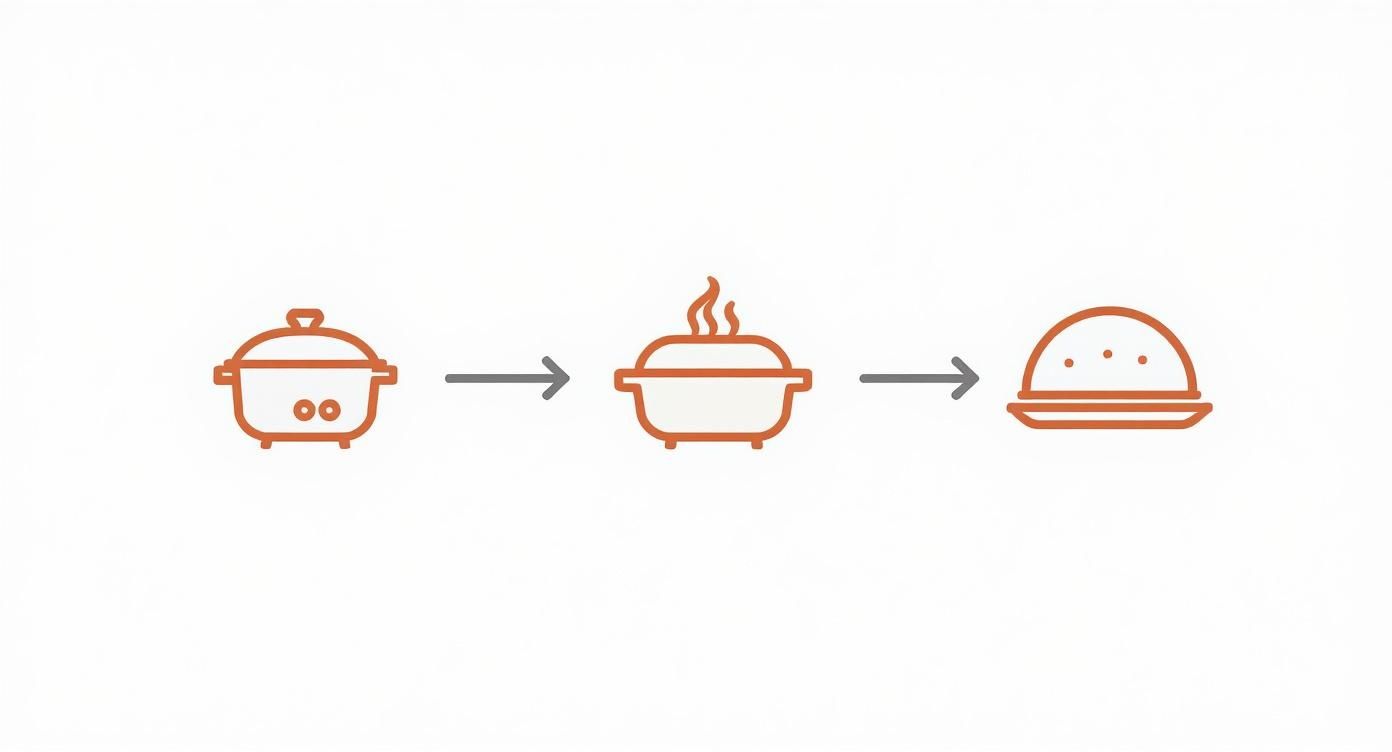
As you can see, your holding and transport equipment is the essential bridge. It’s what guarantees the quality you created in the kitchen actually makes it to the table.
Essential Gear for a Smooth Move
Holding temperature is only half the battle. You also have to physically get everything there in one piece, safely and efficiently. An organized van and the right loading tools are just as critical as the insulated boxes themselves.
- Utility Carts and Dollies: Don't even think about catering without these. They save your back, your team's energy, and prevent injuries. A solid cart moves hundreds of pounds of gear in one trip, turning a dozen small trips into one or two.
- Temperature Monitoring Tools: A good digital food thermometer is non-negotiable. You must temp everything before you leave the kitchen and again upon arrival. It’s the only way to be certain you’re serving safe food.
- Coolers and Ice Packs: For cold items, you need high-quality coolers packed correctly with plenty of ice packs. Pro tip: always keep raw meats sealed tightly on the bottom to prevent drips from contaminating other foods.
Packing a catering vehicle is like a high-stakes game of Tetris. Place heavy items low and secure, make sure nothing can slide around, and always keep raw foods completely separate from ready-to-eat items. Cross-contamination is a caterer's worst nightmare.
Getting these steps right is everything. To dig deeper, learn how to prevent food contamination in our in-depth guide.
Serving Gear: Where Your Hard Work Shines
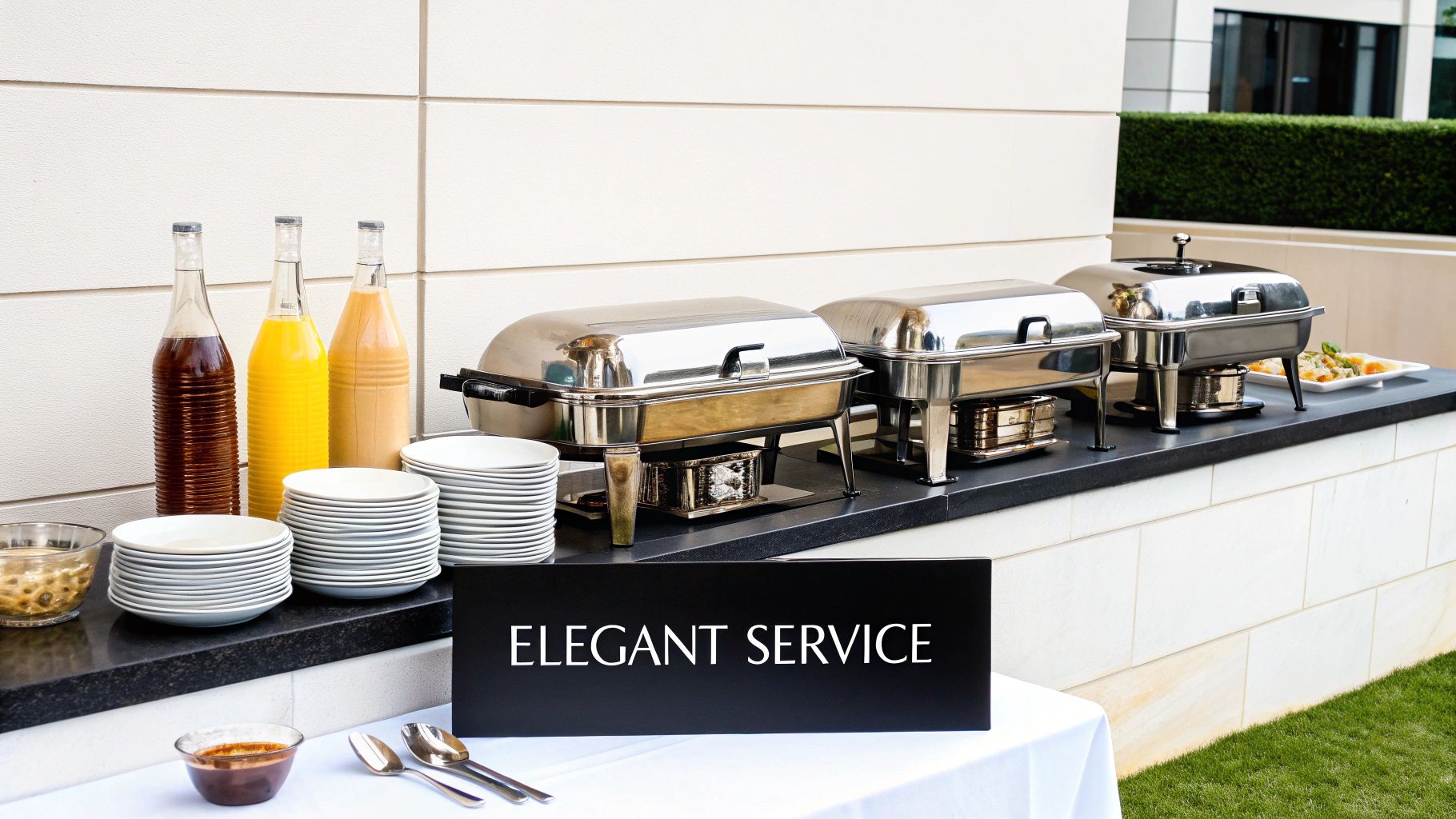
You've spent hours prepping, cooking, and carefully transporting everything. Now comes the moment of truth: the presentation. Your serving equipment connects your culinary creations to the guest, turning a great meal into an unforgettable experience. This is about more than just food on a plate; it’s about crafting an atmosphere that signals professionalism and quality.
The right gear brings an immediate sense of elegance and order to any event. When guests see a beautifully arranged buffet with gleaming chafing dishes and stylish beverage dispensers, they instantly know they're in good hands. Every detail, down to the weight of the forks and the quality of the napkins, shapes their perception of your brand.
Building a Flawless Buffet
For most caterers, the buffet line is the centerpiece of the event. Getting it right is critical for a smooth service that keeps food looking and tasting its best.
Your setup must be both functional for guests and visually impressive. Chafing dishes are the stars of the show, but all supporting equipment plays a vital role. Think carefully about how guests will move through the line and interact with each station. For great strategies on creating an efficient and impressive layout, check out this guide on how to set up buffet tables.
Here are the non-negotiables:
- Chafing Dishes: These are essential for holding hot food at a safe, appetizing temperature. You’ll want a mix of full-size, half-size, and round chafers to handle anything on your menu.
- Serving Utensils: Don't get caught short. You need the right tool for every dish—tongs for salads, slotted spoons for veggies, and deep ladles for soups and sauces. The pro move? Always pack at least two of each so you have a clean backup ready.
- Beverage Dispensers: A must-have. Insulated dispensers are perfect for keeping coffee and hot water steaming, while attractive clear dispensers are great for showing off colorful iced teas, lemonades, or infused water.
A well-stocked serving kit is the mark of a seasoned professional. It shows you’ve anticipated every need, allowing you to handle any situation with grace and efficiency, which builds immense client trust.
The global catering market is massive—projected to hit USD 168.5 billion by 2025. In such a competitive field, a flawless guest experience is what will make you stand out.
How to Calculate Your Tableware Needs
Running out of clean plates or forks halfway through an event is a nightmare. Figuring out your inventory is a simple but vital step. Use these formulas as a baseline, but always add extra to account for drops, seconds, or unexpected guests.
A solid rule of thumb is to plan for 1.5 items per guest for each category. This buffer is your safety net.
- Dinnerware (Plates, Bowls): Guest Count x 1.5
- Flatware (Forks, Knives, Spoons): Guest Count x 1.5 (for each utensil)
- Glassware: Guest Count x 2 (covers water plus another drink)
- Linens (Napkins): Guest Count x 2
This simple math removes the guesswork from packing. You'll arrive on-site confident that you have everything needed to deliver the seamless, high-quality service your clients expect.
The Essential Cleanup and Safety Checklist
The last guest is gone, the music has faded, and the event was a success. But the night's not over. The final, crucial phase of any catering job is the cleanup—this is where true professionals shine.
Leaving the venue spotless isn't just about getting your deposit back; it’s about your reputation and safety. This part of the checklist covers the gear that’s easy to forget but impossible to work without.
Must-Have Cleanup Gear
A chaotic teardown can sour an otherwise perfect event for you and your staff. The right equipment transforms that chaos into a smooth, efficient process. This is your professional exit strategy.
- Heavy-Duty Trash Cans and Liners: Always bring more than you think you need. Having separate cans for trash, recycling, and compost shows you're a modern, conscientious business.
- Bus Tubs and Bins: Your best friends for clearing tables. They prevent spills, reduce breakage, and get dirty dishes back to the washing station in an organized way.
- Cleaning Chemicals and Tools: A well-stocked kit with food-safe sanitizers, degreasers, sponges, scouring pads, and plenty of paper towels is non-negotiable for tackling spills as they happen.
Leaving a venue cleaner than you found it is one of the most powerful forms of marketing. It builds an impeccable reputation with venue managers, who are often your best source for future referrals.
Essential Safety Equipment
A catering event is a whirlwind of hot pans, sharp knives, and slick floors. Being proactive about safety isn't just a good idea—it's your core responsibility to your team.
Make sure this gear is clearly marked and that every staff member knows exactly where it is and how to use it.
- First-Aid Kit: A well-stocked, commercial-grade first-aid kit is mandatory. Minor cuts and burns are common, and you must be able to handle them immediately.
- Fire Extinguishers: You need a Class K fire extinguisher, specifically designed for grease and oil fires common in kitchens. Just as important, your team must be trained on how to use it properly.
- Non-Slip Mats: Falls are one of the most frequent injuries in any kitchen. Placing these mats in prep areas, by fryers, and in the dish pit can prevent a serious accident.
- Portable Handwashing Station: If you're working an outdoor event or a venue with limited facilities, this is a must-have. It's often required by the health department and is critical for maintaining proper food safety.
Catering Equipment FAQs
Stepping into the world of catering can feel overwhelming, especially when you're just starting. You have questions, and getting straight, practical answers is key to building your inventory smartly and avoiding expensive rookie mistakes. It’s all about making solid choices that serve your business today and help you scale up later.
Think of it like stocking a professional kitchen for the first time. You wouldn’t buy a sous-vide machine before you have great knives and pans. It's the same with catering gear; build a solid foundation first.
What should I buy first?
When you’re working with a tight budget, be strategic. The name of the game is versatility. Don't blow your cash on a niche gadget you might use once a year.
Instead, focus on these core areas first:
- Food Prep: Get a set of excellent knives, plenty of cutting boards (to avoid cross-contamination!), and a solid collection of stainless steel mixing bowls. You'll use these tools on every single job.
- Transport & Holding: Your reputation rides on food safety. Insulated food carriers (Cambros) are an absolute must-have from day one. They're non-negotiable for keeping food at safe temperatures.
- Serving Basics: Start simple. You'll need essential serving utensils like tongs and large spoons. A few reliable chafing dishes are also crucial for keeping hot food looking and tasting great on a buffet line.
The single smartest investment a new caterer can make is anything that directly protects food quality and safety. One foodborne illness incident can sink your business overnight. That makes food thermometers and insulated carriers your most valuable assets.
Should I rent or buy equipment?
The classic question. The right answer depends on your business model and how often you'll use a particular item.
For the gear you need at every single event—knives, coolers, insulated carriers—buying is almost always the best financial move in the long run. Owning your core equipment means it’s always available, and you know it's been maintained properly.
However, for big-ticket or specialty items you only need for specific events, renting is your best friend. Think of a cotton candy machine for a carnival-themed party, a massive portable grill for a company picnic, or elegant china for a black-tie wedding. Renting frees up your capital and saves you the headache of storing and maintaining equipment you rarely use.
A great rule of thumb: own your daily workhorses and rent the show ponies. This keeps your operation lean and flexible, which is essential for thriving in the catering world.
Ready to keep every event pest-free? MODERN LYFE offers stylish, effective fly fans that protect your food and impress your guests. Elevate your setup and ensure a flawless guest experience at https://modernlyfe.com.

